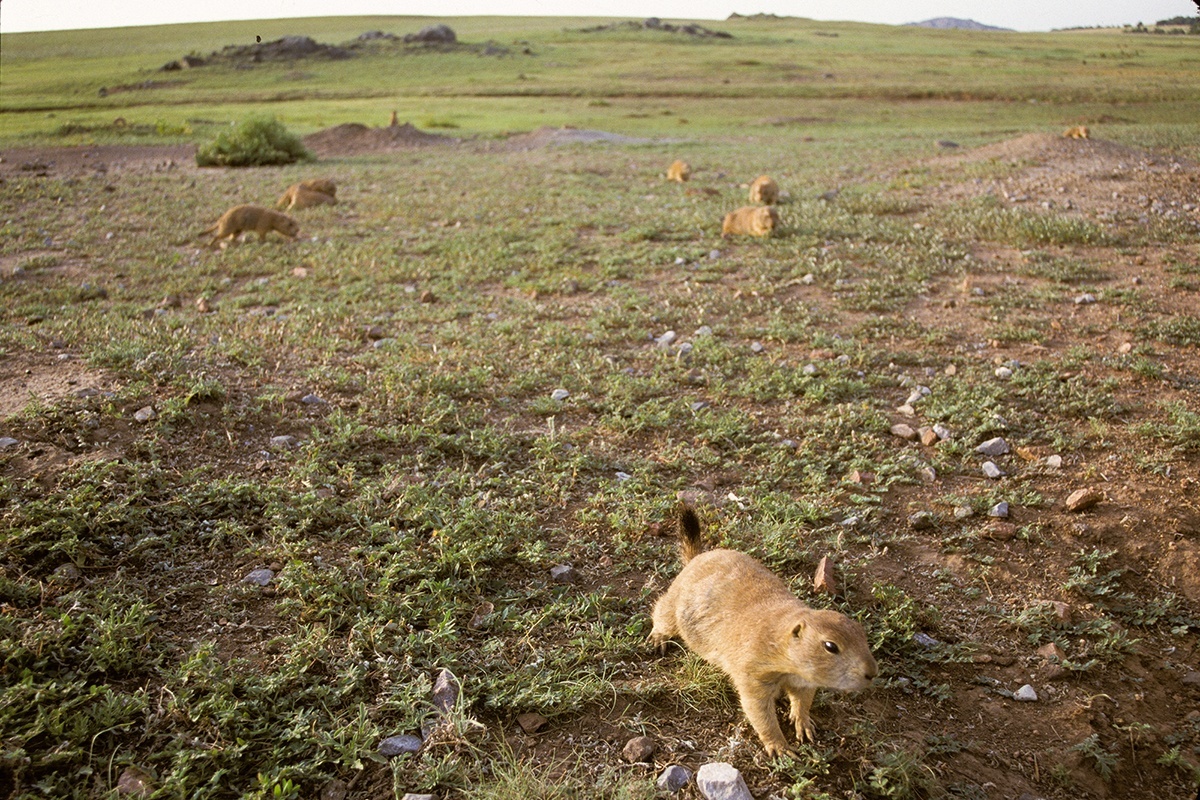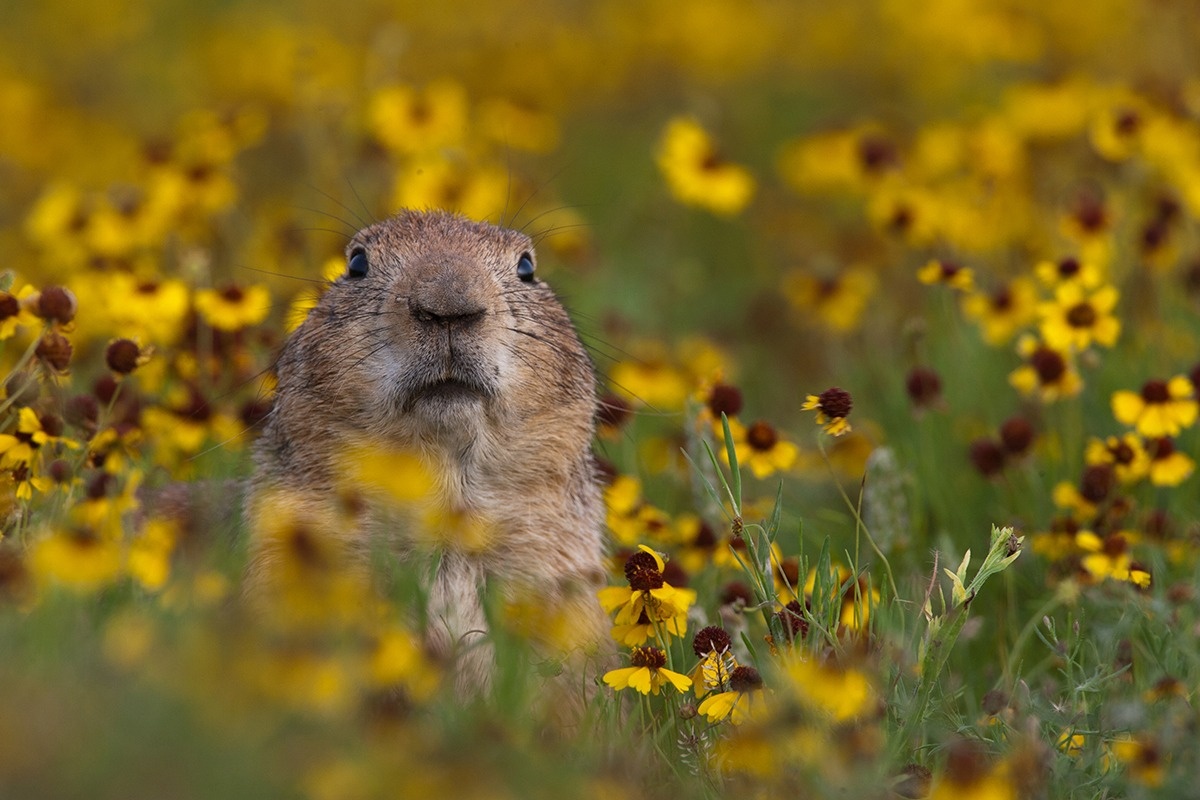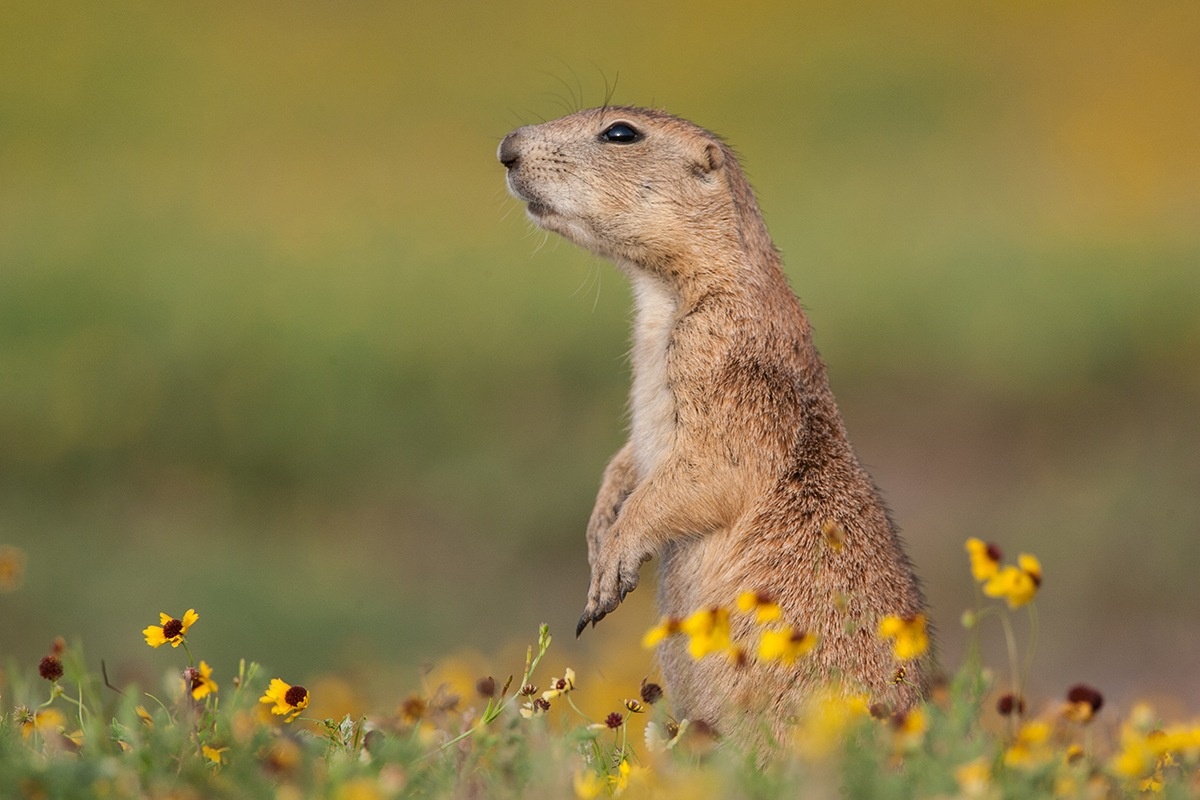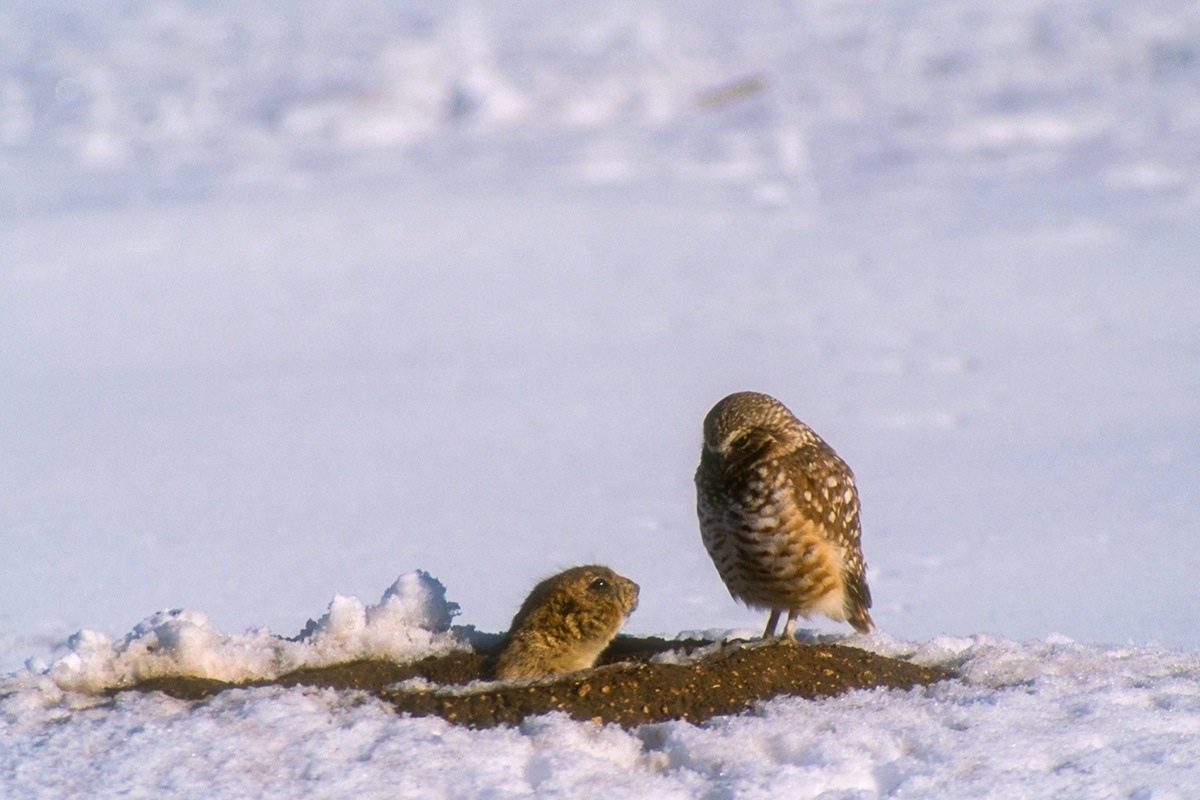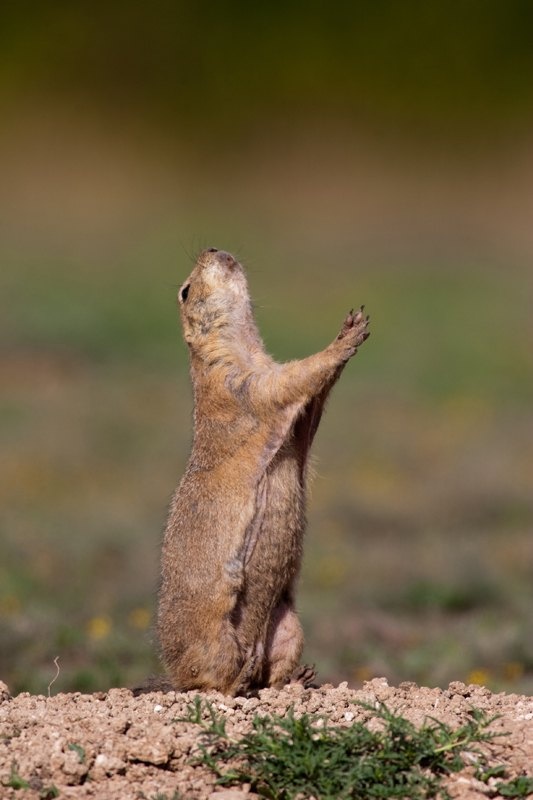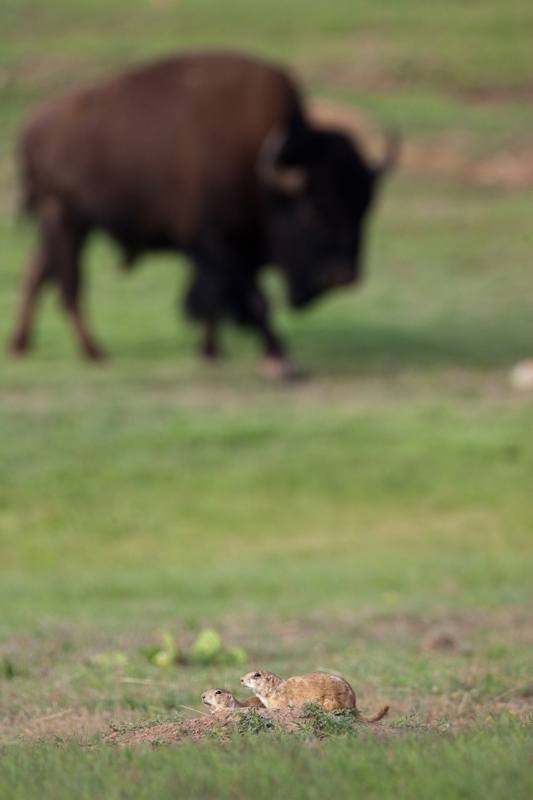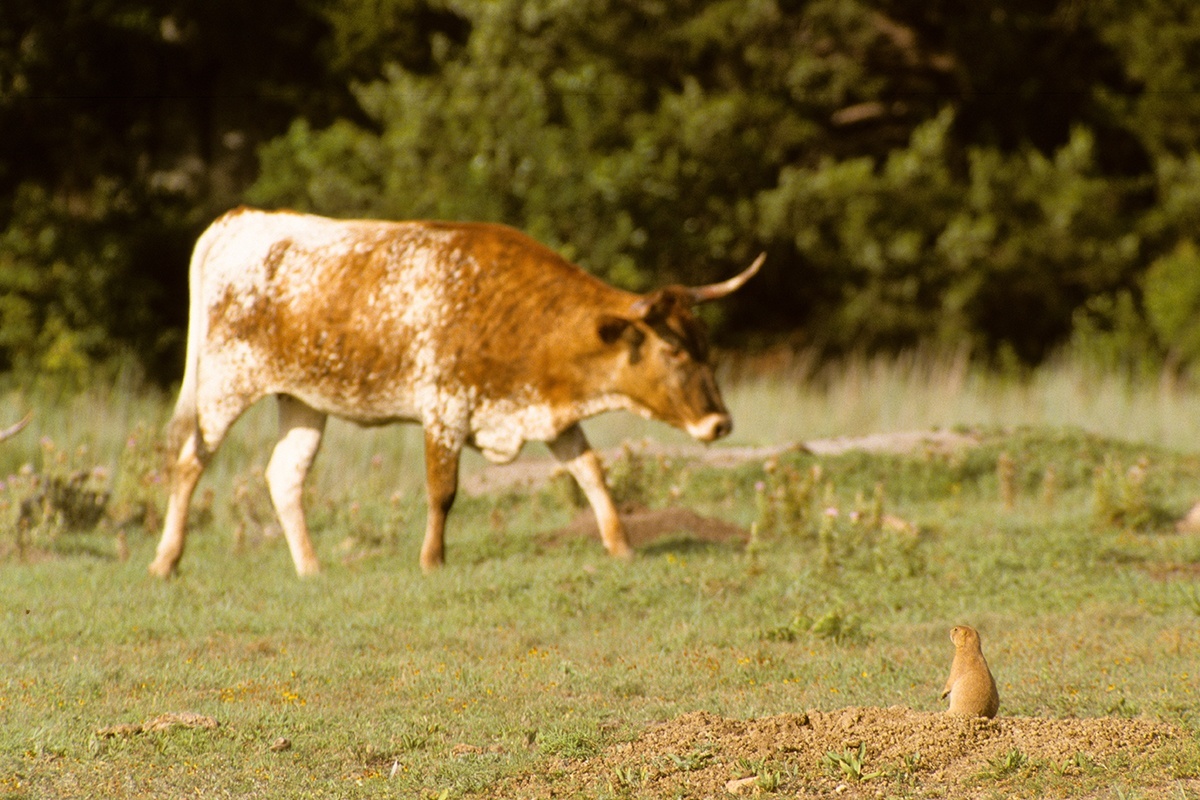Right there,” I said as I pointed, motioning to my wife and kids as we cruised through a remote corner of Floyd County, northeast of Lubbock. Flanking the edge of a dry playa lake, conical mounds of fresh dirt offered confirmation that prairie dogs had started a settlement, called a “town,” on the slope overlooking the broad basin.
While most of the town’s residents seemed to be hunkered underground to escape the relentless March wind, a few of the rodents skittered about as we slowed to take a closer look.
The black-tailed prairie dog is one of four species of prairie dogs in North America and the only species found in Texas. The rodent, historically found west of the 98th meridian, once again occupies pockets of its original range after a century of decline.
Floyd County straddles an ecological area that changes dramatically from west to east. On the county’s western side is the lower edge of the High Plains, a vast zone that gradually tilts downhill so sediment flows east from the Rocky Mountains as it has for eons. Below the Caprock Escarpment, rolling plains ripple eastward to the Texas Cross Timbers. On both sides of the ecological demarcation, prairie dog colonies pepper the landscape.
When I was a teacher, prairie dogs were an integral part of my wildlife education curriculum. Every year, my students mapped a prairie dog town and tested the soil and forage quality to determine the prairie dogs’ effect on the land.
“Like beavers, prairie dogs are known as ecosystem engineers because they dramatically change the landscape,” says Jonah Evans, state mammologist with the Texas Parks & Wildlife Department. “The short grasses and burrow systems in prairie dog towns create important habitat that benefits multiple species, including pronghorn, burrowing owls, black-footed ferrets, Sprague’s pipit, horned lark and many more.”
As we drive, we see small towns here and there across the plains. The largest covers perhaps an acre. At every town, we see prairie dogs foraging or sitting up, keeping watch for predators and crying out their high-pitched “chirk” at any hint of danger. The call alerts other prairie dogs, which scurry to the safety of their subterranean burrows to wait for the all-clear.
Even though prairie dogs are abundant in spots across Texas, their number and the range they occupy is only a tiny percentage of what it once was.
A Century of Decline
In the 1901 edition of the U.S. Department of Agriculture’s Yearbook of Agriculture, C. Hart Merriam, chief of the Division of Biological Survey, submitted a report titled The Prairie Dog of the Great Plains. In his report, he cited a prominent Texas newspaper as editorializing:
“No man who has not gone through the portions of Texas infested by prairie dogs can conceive the enormous ravages they have committed. Millions of acres of land once covered with nutritious grasses have been eaten off by these animals, until the land is naked and worthless, and will remain worthless so long as the prairie dog remains. They invade the farms and eat down the growing crops. Here and there individual effort has been made to destroy them, without avail, and their numbers steadily increase, until they are a menace to the prosperity of the land.”
Four years later, Vernon Bailey released the Biological Survey of Texas, in which he described a prairie dog town that stretched 260 miles, from San Angelo to Clarendon. That town was about 100 miles wide and, in Bailey’s estimation, covered 16 million acres.
Black-tailed prairie dogs were tapped for eradication by the dawn of the 20th century. The rodents were plentiful and stood in the way of settlers taming the grasslands for fattening cattle or growing crops.
In 1898, B.A. Owen, a ranch manager, wrote, “I ordered 100 pounds of strychnine and 400 pounds of cyanide of potash through Doss Brothers of Colorado City. We got started about Dec. 1st and worked 15 men all that winter and had success. The next year we had a good season and the grass was knee high all over the ranch. Mr. Godair [the ranch owner] came to the ranch the next fall and asked me what I had to spend on the dogs. I told him approximately $6,000 and he said he wouldn’t have them back for $20,000.”
Over the next quarter century, black-tailed prairie dog numbers dropped 25 percent, as confirmed by official reports such as the Yearbook of Agriculture. In 1922, government agents poisoned more than 1 million acres of prairie dog country in Texas and eradicated 90 percent of the animals in the process.
In 1924, researchers sealed the prairie dog’s fate for the next generation of animals when they reported, “The prairie dog is one of the most injurious rodents of the Southwest and Plains region. These animals assemble in areas called towns, where populations become very high; thus, the removal of vegetation in its entirety from the vicinity is common.” After the report was published, eradication efforts continued across the Great Plains.
As the numbers of prairie dogs dropped precipitously nationwide, their eradication was nearly complete in Texas. In 1870, Texas prairie dogs were estimated to cover 56.8 million acres. By 1998, that number had been reduced to 22,500 acres—a 99.96 percent drop. Since then, prairie dogs have maintained a steady population.
Anatomy of an Earth Mover
When prairie dogs colonize an area, their incessant digging creates habitat for other animals. Badgers, burrowing owls, snakes and rabbits are among those that occupy active and abandoned burrows. When the plains were full of prairie dogs, their presence helped maintain a complicated grassland ecosystem that supported the largest concentrations of mammals in North America, including vast herds of grazers such as bison and pronghorn.
Every prairie dog town is segmented into neighborhoods called coteries. These coteries are typically made up of related prairie dogs, and the inhabitants of each coterie don’t necessarily get along with those next door. Extra-coterie fighting occurs between prairie dogs to resolve territorial disputes.
Coteries typically cover an acre and include 50–100 burrows. The burrows aren’t interconnected, and many feature only a single opening. Most, however, have entrance and exit openings, and the two allow enough of a draft to keep the burrows’ subterranean temperature at a comfortable range of 50–70 degrees.
Inside the dirt mounds, females whelp three to five pups of mixed gender. The babies remain inside the burrow for the first six weeks and then emerge to integrate into the coterie. They spend their days playing and feeding on grasses, insects and prickly pears.
Even though they isolate themselves into small communities, prairie dogs have evolved to live communally in large groups because the larger community provides more eyes to watch for danger. When a prairie dog spots a predator such as a coyote or hawk, it makes a high-pitched alert called a chirk. The closer the danger, the faster the chirk. When the call goes out, other prairie dogs take notice.
Prairie dogs chirk until the last possible moment, when they duck into the burrow. When the danger is passed, they call out with a “jump-yip.” The jump-yip is an animated call created when a prairie dog rises on its back legs, throws its head back and announces that the coast is clear.
The Future of Prairie Dogs
Based on the species’ decline, it seems that prairie dogs should be listed as an endangered species, but they are not. In 1998, the National Wildlife Federation petitioned the United States Fish and Wildlife Service to list the prairie dog as a threatened species. Threatened species status, while not as dire as endangered species status, still brings a degree of oversight on privately owned lands.
After hearings and lobbying on both sides of the prairie dog issue, the USFWS ruled that even though the prairie dog is warranted for inclusion on the threatened species list, its listing was precluded. Instead, the service opted on a plan in which individual states could submit restorative plans to manage and mitigate the prairie dog’s demise.
Texas’ plan, adopted in 2004, states, “The Management Plan is a step-by-step plan to reach the statewide goal of 293,129 acres of occupied prairie dog habitat by 2011.” Even though a count is in progress, it is not clear that the habitat goal was reached.
The approach to achieve the habitat goal was based on five points: understanding the exact population of the black-tailed prairie dog in Texas, implementing outreach and educational programs, developing management options that conserve prairie dog populations, tightening regulations that protect prairie dogs and establishing research programs that support long-term population viability.
It’s unlikely that the prairie dog will ever occupy the entirety of its original range. The agribusiness infrastructure and human settlement forbid it from a practical standpoint. However, there are still special pockets of rangeland where prairie dogs thrive.
In rural Floyd County, my family and I saw a few.
——————–
Writer and photographer Russell A. Graves is a member of South Plains EC and author of The Prairie Dog: Sentinel of the Plains.
